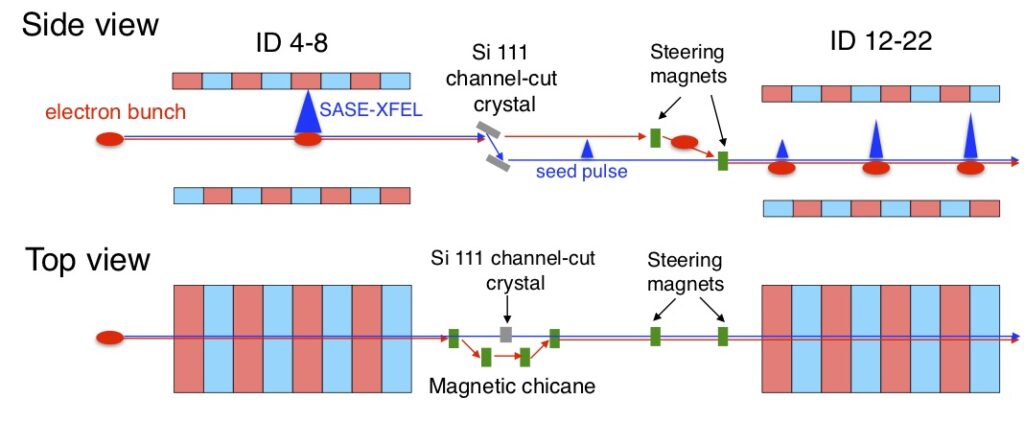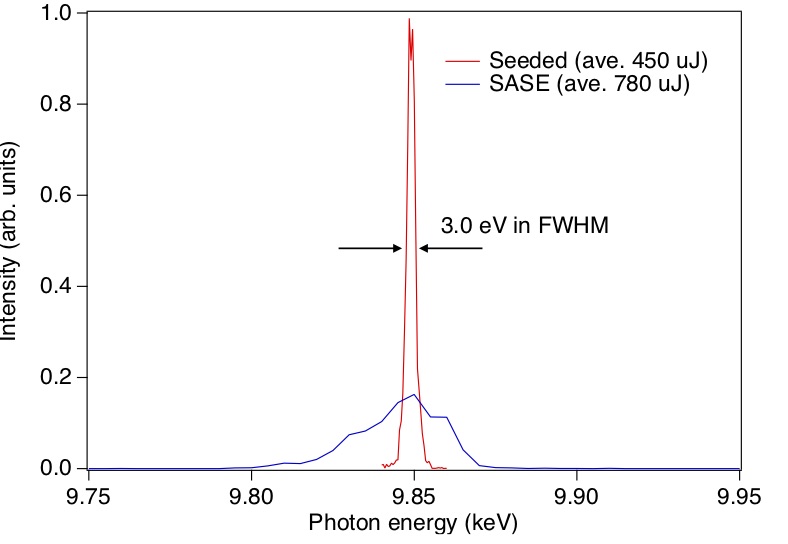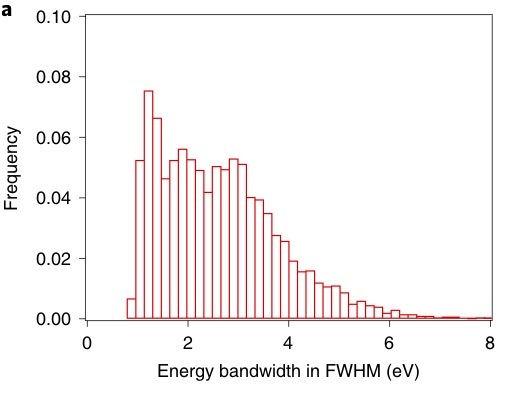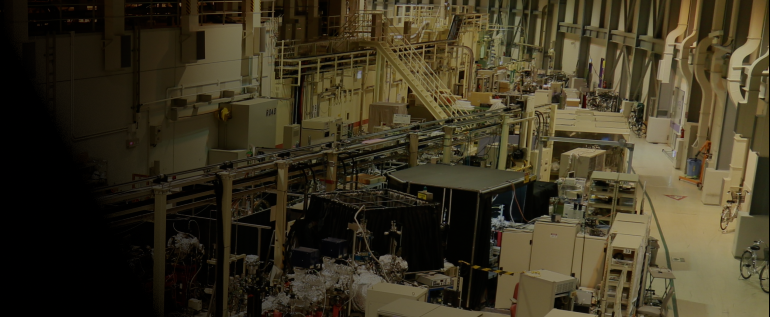セルフシードXFEL
BL3においては、反射型セルフシード方式(図1)による狭帯域XFELの利用が可能です。セルフシードXFELは、SASE型XFELと同等の平均パルスエネルギーを有しつつ、高い単色性を示します。この方式のXFELの提供には1シフト程度の調整時間が必要です。また、波長変更にも通常より長い時間を要します。これらの調整時間はユーザービームタイムに含めます。セルフシードXFELの利用を計画されている場合は、利用可能な波長条件などについて、課題申請前にこのメールアドレスはスパムボットから保護されています。閲覧するにはJavaScriptを有効にする必要があります。まで必ずお問い合わせください。

図1. SACLAにおける反射型セルフシード方式の概略図。反射型セルフシードでは、アンジュレータを2つのセクションに分けて、その間にシリコンで出来たチャンネルカット結晶を設置します。前半部で発振させたXFELをこの分光結晶によって単色化します。そして、この単色化した種光を後半部のアンジュレータで増幅させることで、狭帯域XFELを生成します。
セルフシードXFELのスペクトル
XFELのスペクトル幅(ΔE/E)は、0.03%程度です。これはSACLAの通常の運転モードと比較して約10分の1になります。一方で、セルフシードモードのパルスエネルギーは、通常モードのおよそ60%になります。例として図2に通常の運転モードとセルフシードモードにおけるスペクトルを示します。

図2. 通常の運転モードとセルフシードモードのスペクトルの比較。
ショットごとのエネルギー幅のゆらぎ
セルフシードモードでは、ショットごとにXFELパルスの光子エネルギー幅が異なります。これは、電子ビームの性質(特に、エネルギーチャープ)がパルスごとに異なることに起因しています。図3にショットごとの光子エネルギー幅のヒストグラムを示します。スペクトル幅の情報が実験データの解析に必要な場合は、EH1のシングルショットスペクトロメーターを用いてショットごとのスペクトルを実験と並行して測定することが可能です。

図3. セルフシードXFELのパルスごとの光子エネルギー幅のヒストグラム(10 keVのセルフシードXFEL).
発振可能な光子エネルギーとパルスエネルギーの目安
| 光子エネルギー | 7-15 KeV |
| エネルギー幅 | 0.03% |
| パルスエネルギー | 200 µJ@7-10 keV, ~100 µJ@15 keV |
Self-Seed XFEL
At BL3, a narrow band of XFEL can be used with the reflective self-seed method (figure 1). Self-seed XFEL have the same average pulse energy as SASE XFEL, but exhibit high-monochromaticity. Providing this type of XFEL requires an adjustment time of approximately one shift. In addition, it takes longer than usual to change the wavelength. These adjustment times are included in the user’s beam time. If you are planning to use self-seed XFEL, please be sure to contact the このメールアドレスはスパムボットから保護されています。閲覧するにはJavaScriptを有効にする必要があります。 for information on the available wavelength conditions before applying for an assignment.
References:
I. Inoue et al., Nature Photon. 13, 319 (2019).

Figure 1: A schematic diagram of the reflective self-seeding method at SACLA. In reflective self-seeding, the undulator is divided into two sections, with a channel-cut crystal made of silicon installed between them. The XFEL oscillated in the first half are monochromatized by this analyzer crystal. Then, by amplifying this monochromatic seed-light with the undulator in the latter half, a narrow band of XFEL is generated.
Characteristics of self-seed XFEL
Self-seed XFEL spectrum
The spectral width (ΔE/E)of the XFEL is approximately 0.03%. This is about one-tenth of the normal operating mode for SACLA. On the other hand, the pulse energy of the self-seed mode is approximately 60% of the normal mode. Figure 2 shows an example of the spectrum of the normal operating mode and the self-seed mode.


Figure 2: A comparison between the spectrum of normal operation and self-seed operation.
Fluctuations of the energy width for each shot
During self-seed operation, the photon energy width of the XFEL pulse is different for each shot. This is due to the fact that the nature of the electron beam varies from pulse to pulse (especially the energy chirp). Figure 3 shows a histogram of the photon energy width for each shot. If spectral width information is required to analyze experimental data, the EH1 single-shot spectrometer can be used to measure the spectrum for each shot in parallel with the experiment.

Figure 3: A histogram of photon energy width for each pulse of self-seed XFEL (10 keV self-seed XFEL).
Guidelines for photon energy and pulse energy that can be oscillated
| Photon energy | 7-15 keV |
| Energy width | 0.03% |
| Pulse energy | 200 µJ @ 7-10 keV, ~100 µJ @ 15 keV |
